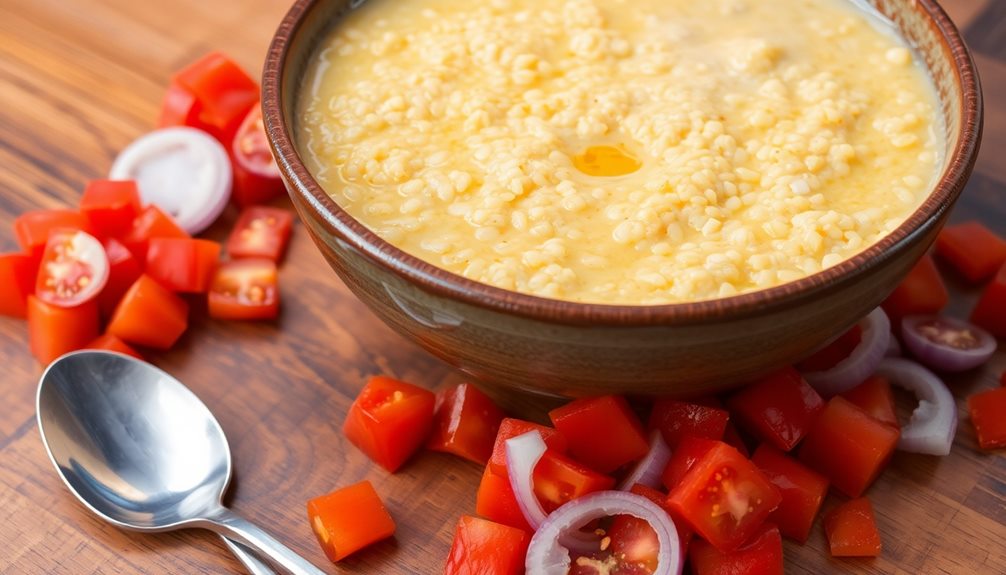West African leafy greens are packed with essential nutrients like vitamins, minerals, and bioactive compounds that boost your health and immune system. They’re used in traditional medicine to fight inflammation, support digestion, and prevent deficiencies. You can enjoy them cooked in stews, blended into smoothies, or dried into powders for year-round use. Their rich cultural significance and medicinal benefits make them a crucial part of local diets. Exploring further will reveal how these greens can enhance your well-being.
Key Takeaways
- West African leafy greens are rich in nutrients like vitamins, minerals, and bioactive compounds supporting overall health.
- These greens are used in traditional herbal remedies for inflammation, digestion, and anemia.
- They are commonly cooked into stews, soups, or eaten fresh, with preparation methods that preserve nutrients.
- Dried powders of these greens ensure year-round access and ease of incorporation into daily diets.
- Their bioactive compounds offer antioxidant, anti-inflammatory, and immune-boosting health benefits.

Have you ever wondered how West African leafy greens pack such powerful nutrition into each bite? These vibrant greens are more than just ingredients in traditional dishes; they’re a treasure trove of health benefits that have sustained communities for generations. Their rich nutrient profiles make them essential components of both everyday cuisine and herbal remedies, blending flavor with healing properties effortlessly. When you incorporate these greens into your diet, you’re not only adding fresh, earthy flavors but also tapping into centuries-old practices that promote wellness. Many of these greens, like jute leaves or moringa leaves, are used in herbal remedies to treat ailments such as inflammation, digestive issues, and anemia. Their natural medicinal qualities have made them crucial in local health practices, often replacing or complementing pharmaceutical options. Understanding the nutritional value of these greens highlights their importance in supporting overall health and preventing deficiencies. Additionally, their bioactive compounds contribute to their antioxidant and anti-inflammatory effects, enhancing their role in traditional healing. These compounds also help protect the body against oxidative stress and support immune function.
In the kitchen, these greens serve multiple culinary uses. They are often cooked down into hearty stews, soups, or sauces, where their slightly bitter, earthy taste enriches the dish. You might find them in popular West African dishes like palava sauce or gboma dovi, where their tender leaves absorb spices and flavors beautifully. Some greens are used fresh in salads or as garnishes, adding a nutritious crunch and vibrant color. Their versatility allows them to be prepared in numerous ways—blended into smoothies, wilted as a side, or even dried and ground into powders that can be stored and used later. When cooking with these greens, you retain most of their nutrients, ensuring you benefit from their vitamins, minerals, and antioxidants. This preservation of nutrients underscores the importance of proper preparation methods to maximize health benefits. Proper cooking techniques also help reduce any bitterness, making the greens more palatable without sacrificing their nutritional qualities.
Culinary uses extend beyond just flavor; they’re a way to connect with cultural traditions and promote health. Many communities believe that consuming these greens helps boost immunity, improve digestion, and increase energy levels. Their herbal remedies usage stems from knowledge passed down through generations, emphasizing their role in holistic health. For example, moringa leaves are rich in vitamin C, calcium, and potassium, making them an excellent supplement for those lacking essential nutrients. Likewise, jute leaves contain fiber and iron, supporting blood health and digestive function. These greens are often dried and processed into powders, making them accessible even when fresh produce isn’t available, allowing their benefits to be enjoyed year-round. Incorporating these greens into daily diets can contribute significantly to nutritional balance and overall well-being. Recognizing their traditional significance can deepen appreciation for their role in sustaining health and culture.
Frequently Asked Questions
How Do West African Leafy Greens Compare to Global Leafy Green Nutrition?
You might wonder how West African leafy greens compare to global leafy greens with regard to nutrition. The nutritional comparison shows that these greens are often rich in vitamins, minerals, and antioxidants, sometimes even surpassing their global counterparts. By choosing West African varieties, you get a diverse range of nutrients that can boost your health. Their unique nutrient profiles make them a valuable addition to your diet, alongside other global leafy greens.
Are There Any Known Health Risks Associated With Consuming West African Leafy Greens?
You might wonder if eating West African leafy greens poses health risks. While generally nutritious, there are toxicity concerns, especially if they contain high pesticide residues or contaminants. Always wash greens thoroughly and source them from trusted suppliers to minimize risks. Though rare, some greens could harbor harmful substances, so being cautious helps guarantee you enjoy their benefits safely without exposure to potential dangers.
What Traditional Dishes Incorporate These Leafy Greens?
You’ll find West African leafy greens featured in traditional recipes like palaver sauce, where they’re cooked with fish, tomatoes, and spices, or in soups and stews that highlight their hearty texture. Culinary pairings often include peanuts or yams, enhancing flavor and nutrition. These greens also appear in side dishes or salads, making them versatile ingredients that connect you to rich cultural culinary traditions.
How Can These Greens Be Stored to Maintain Nutritional Value?
To preserve the nutritional value of these greens, you should focus on proper storage methods and preservation techniques. Keep them refrigerated in breathable bags or containers to slow down nutrient loss. Avoid washing until you’re ready to use them, as excess moisture accelerates spoilage. For longer storage, blanch and freeze the greens. These storage methods help retain their vitamins, minerals, and freshness, ensuring you get the most health benefits from your leafy greens.
Are There Any Seasonal Variations in Their Nutritional Content?
You might notice seasonal nutrient fluctuations in leafy greens, influenced by harvest timing effects. During peak seasons, these greens often have higher levels of essential vitamins and minerals, while off-season harvests may show reduced nutritional value. To maximize health benefits, try to consume them during their natural harvest periods when nutrient density is at its highest. This way, you get the most nutrition from your leafy greens year-round.
Conclusion
As you’ve seen, West African leafy greens pack powerful nutrients that can transform your health. But there’s more beneath the surface—secrets these greens hold that could change everything you know about nutrition. Will you discover their full potential and access a new level of vitality? The next step is yours to take. Don’t just read about their wonders—dare to explore what lies beyond, and let these greens redefine your understanding of nourishment. The choice is in your hands.










